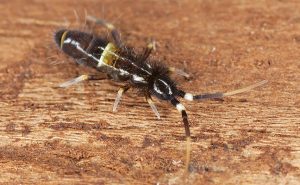As the days get longer and outdoor temperatures begin to increase, homeowners start feeling the desire to head outside and clean up their back yards. Pest management professionals (PMPs) can provide an added-value service to their clients by recommending preventive pest management tasks during outdoor “spring cleaning” activities. In particular, a few easy things can be done to minimize the likelihood of population outbreaks of one of the tiniest pests encountered by PMPs.
Springtails (Order Collembola) are a group of hexapods less than 1/8 inch long. They thrive in damp areas, where they feed on fungus and decaying organic matter. The common name comes from their propensity to “spring” into the air using their tail-like structure (furcula) as a catapult when disturbed. Springtails are most commonly encountered indoors when fungus or mildew begins to grow in moist locations, such as kitchens and bathrooms, or in walls associated with a leaky window or door.
Typically, the best advice for a client is to eliminate the source of the moisture, allowing the area to dry out and creating conditions that are inhospitable for springtails to survive indoors. While this is sound advice, it’s also important to eliminate the conditions that allow outdoor springtail populations to thrive as well, so they do not migrate inside. Encourage clients with perennial springtail invasions to do the following:
- Clean up fallen leaves adjacent to foundation walls.
- Move stored items like woodpiles or other items that can limit airflow.
- Consider eliminating mulch beds in areas that are shaded or damp.
During routine exterior inspections, look for moss growing on the ground, patios or foundation walls. This is a sure sign that the area is damp and springtails may be present.
Taking advantage of your customer’s interest in working in the yard on pleasant spring days can go a long way toward limiting the likelihood you will get called back for an unscheduled visit.
You can reach Contributor Dr. Jim Fredericks, VP of technical and regulatory affairs for the National Pest Management Association (NPMA), at jfredericks@pestworld.org.

Leave A Comment